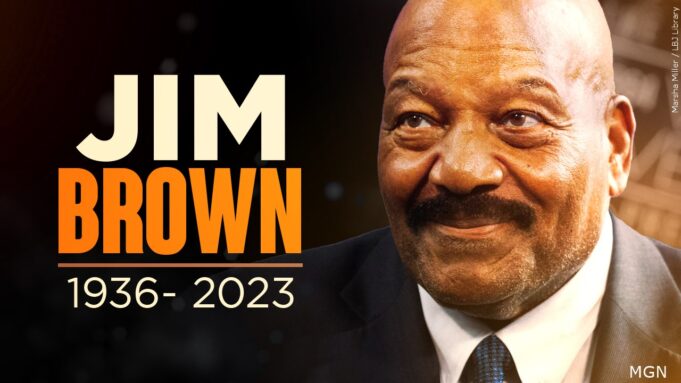The passing of James Nathaniel Brown, known to the world as Jim Brown, has left many saddened, but people finding comfort in his remarkable contributions to humanity, including his athleticism, civil/human rights activism, films, and peacekeeping discussed why he will always be remembered.
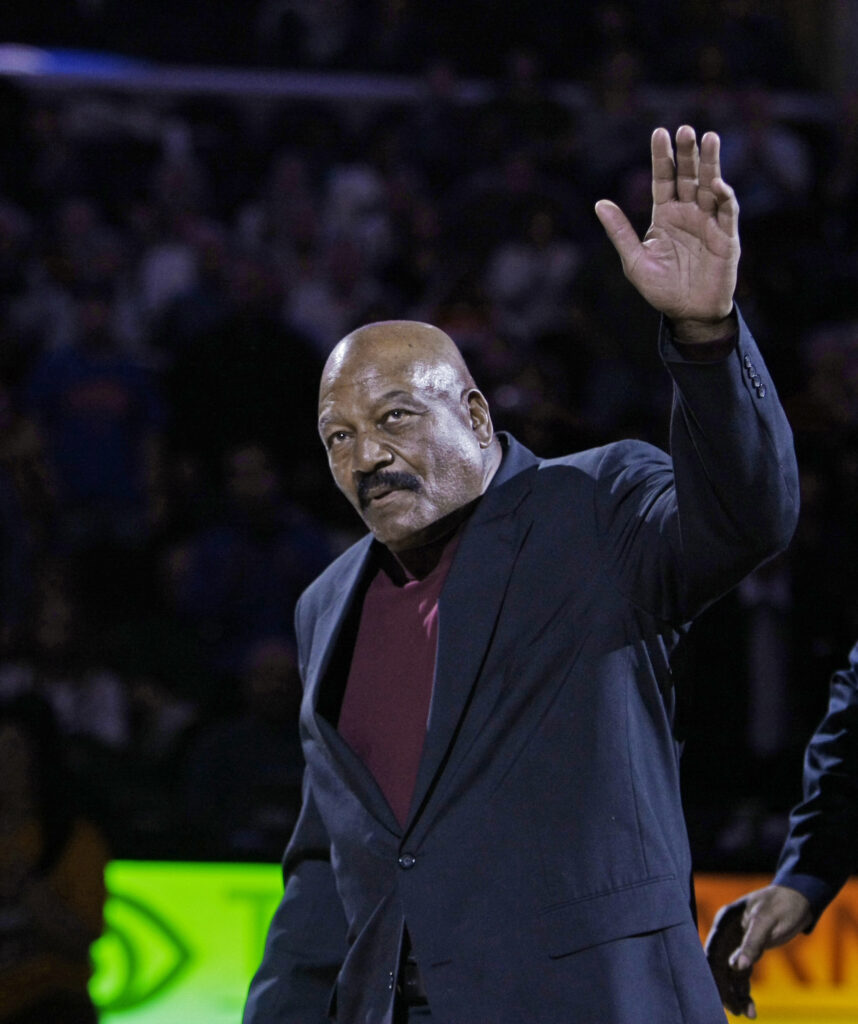
With profound sadness, his wife, Monique Brown, announced his passing on Instagram: “He passed peacefully last night at our L.A. Home. To the world he was an activist, actor, and football star. To our family, he was a loving and wonderful husband, father, and grandfather. Our hearts are broken… .” Mr. Brown passed away at the age of 87 on May 18.
In the 1960s as a member of the Nation of Islam, Muhammad Ali shared his reasons for refusing the draft during the Vietnam War at a meeting of the Negro Industrial and Economic Union in Cleveland on June 4, 1967. Jim Brown was among the professional athletes (including Bill Russell, Kareem Abdul Jabbar, Carl Stokes, Walter Beach, Bobby Mitchell, Sid Williams, Curtis McClinton, Willie Davis, Jim Shorter, and John Wooten) who stood with the boxer who was outspoken on racism and issues that impacted Black America.
“My sincerest condolences to Monique and the entire Brown family. I am here for you in friendship & forever,” tweeted Kareem Abdul-Jabbar, the NBA Hall of Famer. He posted that when he was 20, Mr. Brown invited him to attend the Cleveland Summit, which was Mr. Abdul-Jabbar’s first public support for Muhammad Ali. “Jim’s dedication to the fight for equal rights was a lifelong effort and something that enabled me to maintain our friendship for over 50 years. The world and I will miss him greatly,” read his tweet.
Former Detroit Lions running back Barry Saunders posted, “You can’t underestimate the impact #JimBrown had on the @NFL. He will be greatly missed. Additionally, his generosity and friendship with my family is a gift that we will always treasure. Our thoughts & prayers are with the Brown Family & @Browns fans at this time.”
Mr. Brown, was a Cleveland Browns Hall of Fame running back and was inducted into the Pro Football Hall of Fame in 1971 and named to the NFL’s 100th anniversary all-time team in 2019.
The NFL extended condolences to Monique Brown and their family in a statement from Commissioner Roger Goodell. “Jim Brown was a gifted athlete—one of the most dominant players to ever step on any athletic field—but also a cultural figure who helped promote change.
During his nine-year NFL career, which coincided with the civil rights movement here at home, he became a forerunner and role model for athletes being involved in social initiatives outside the sport. He inspired fellow athletes to make a difference, especially in the communities in which they lived,” said Mr. Goodell.
“It’s impossible to describe the profound love and gratitude we feel for having the opportunity to be a small piece of Jim’s incredible life and legacy. We mourn his passing, but celebrate the indelible light he brought to the world,” The Cleveland Browns said in a statement on Twitter. “Jim Brown Forever,” tweeted the Cleveland Browns, who called him a legend, leader, activist and visionary.
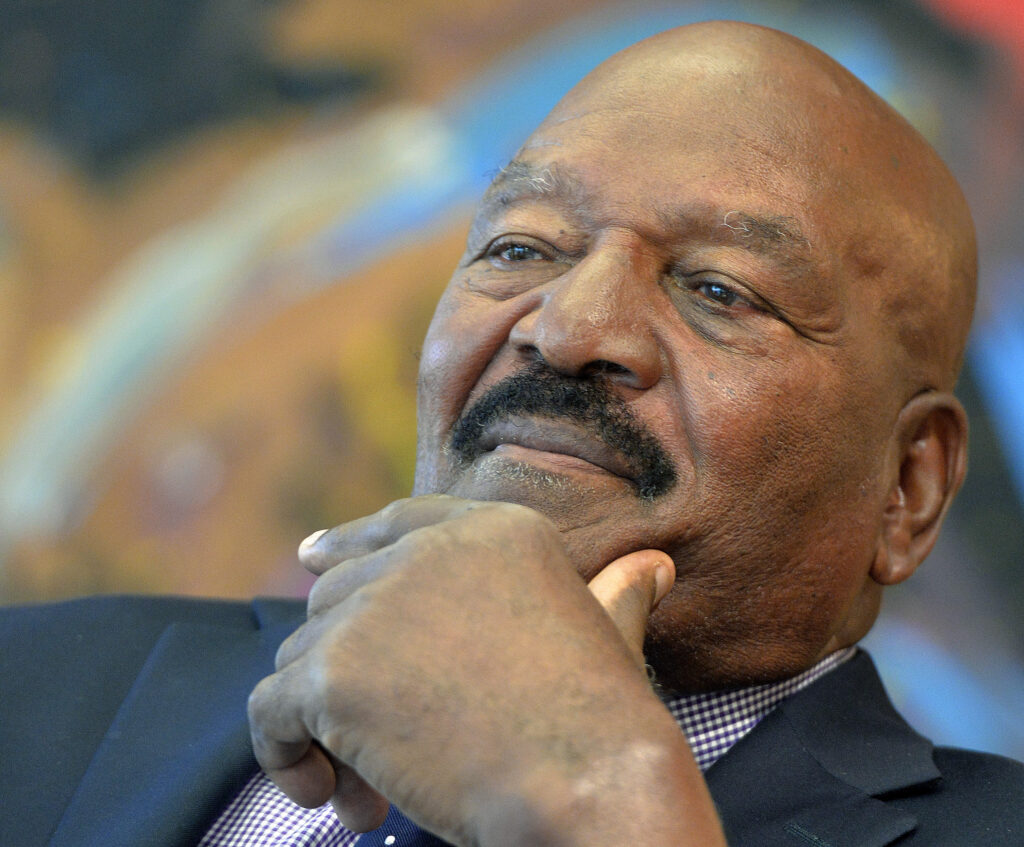
“We lost a hero today. Rest in Paradise to the legend Jim Brown. I hope every Black athlete takes the time to educate themselves about this incredible man and what he did to change all of our lives. We all stand on your shoulders Jim Brown,” said Lebron James of the L.A. Lakers on Instagram on May 19.
“If you grew up in Northeast Ohio and were Black, Jim Brown was a God. As a kid who loved football, I really just thought of him as the greatest Cleveland Brown to ever play. Then I started my own journey as a professional athlete and realized what he did socially was his true greatness. When I choose to speak out, I always think about Jim Brown. I can only speak because Jim broke down those walls for me,” the NBA all-time leading scorer continued.
“I am so grateful that I was able to call you my friend. I hope I can continue to honor your legacy with my words and actions. My prayers to your family. I know they are all incredibly proud of everything you did for our community! #LegendsNeverDie,” added Mr. James’ post.
Gang intervention work
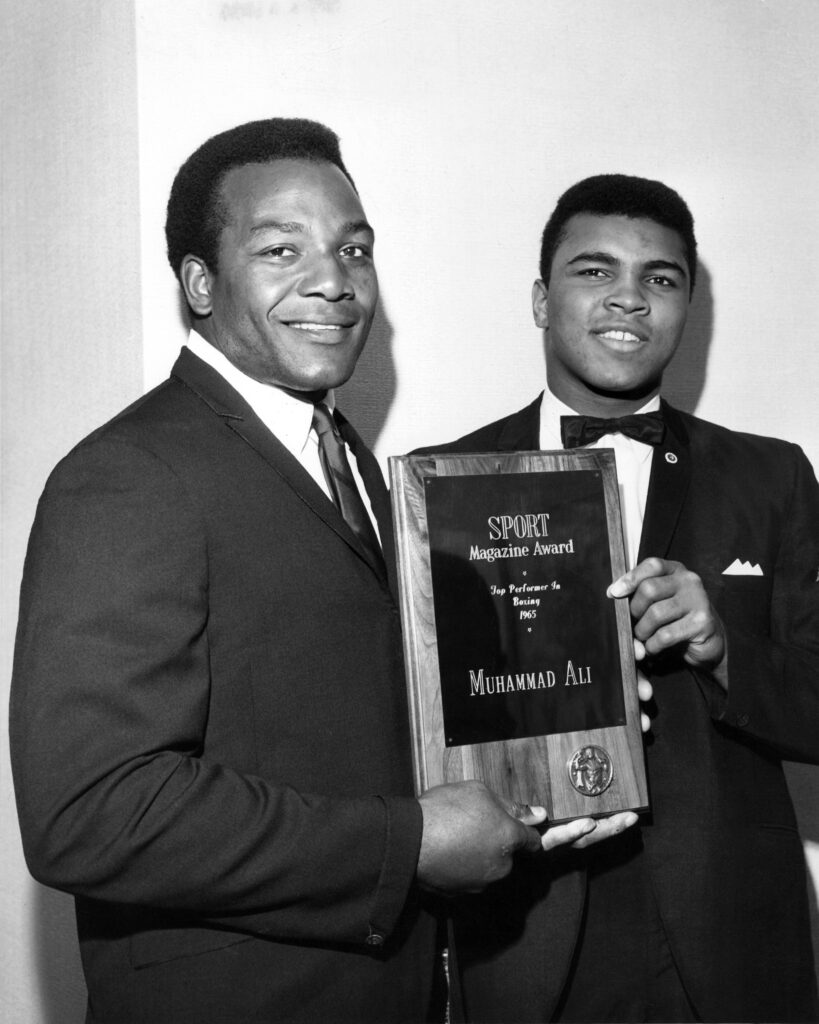
Mr. Brown was a man who made his own decisions even if others did not understand or agree with him and like all human beings, he was imperfect. But his conflict resolution efforts, which he was fully committed to, saved and impacted many lives.
Student Minister Abdul Malik Sayyid Muhammad, Western Region Representative of the Honorable Minister Louis Farrakhan and the Nation of Islam, grew to know and love Mr. Brown through his Amer-I-Can Life Skills Management Program, now being taught in schools, jails, and prisons across the country.
“I learned a lot from Jim, in terms of how Jim related to the brothers and sisters in the street, being that he’s the great, Jim Brown, legendary football player and actor. Similar to Harry (Belafonte), he didn’t have that kind of chip on his shoulder, thinking he was ever better than his people,” stated Student Min. Muhammad.
According to Student Min. Muhammad, Mr. Brown’s interactions with gang leaders and members left a lasting impact. By providing support and encouragement, he empowered them to transition from a negative to a positive lifestyle. This approach was incredibly influential and meaningful.
“That won me over! Because he had a powerful, powerful Amer-I-can program, which actually became the catalyst and I would say the template for gang intervention in Los Angeles, that started maybe a few years after Amer-I-Can,” explained Student Min. Muhammad.
“He was like the go-to cat for all these brothers and sisters in the streets. They trusted Jim and they could go to Jim for advice and it was just beautiful to see that all these brothers and sisters in the streets—hardened, ex-criminals—trusted Jim Brown because it’s hard to win the trust of the streets,” he stated.
Student Min. Muhammad expressed admiration for Mr. Brown’s exceptional achievements, emphasizing that his unparalleled athletic accomplishments during the turbulent 1960s, a time marked by significant challenges for Black people, solidify his status as the greatest. Additionally, he acknowledged Mr. Brown’s courageous stance as one of the first Black athletes to jeopardize his career for the advancement of Black people.
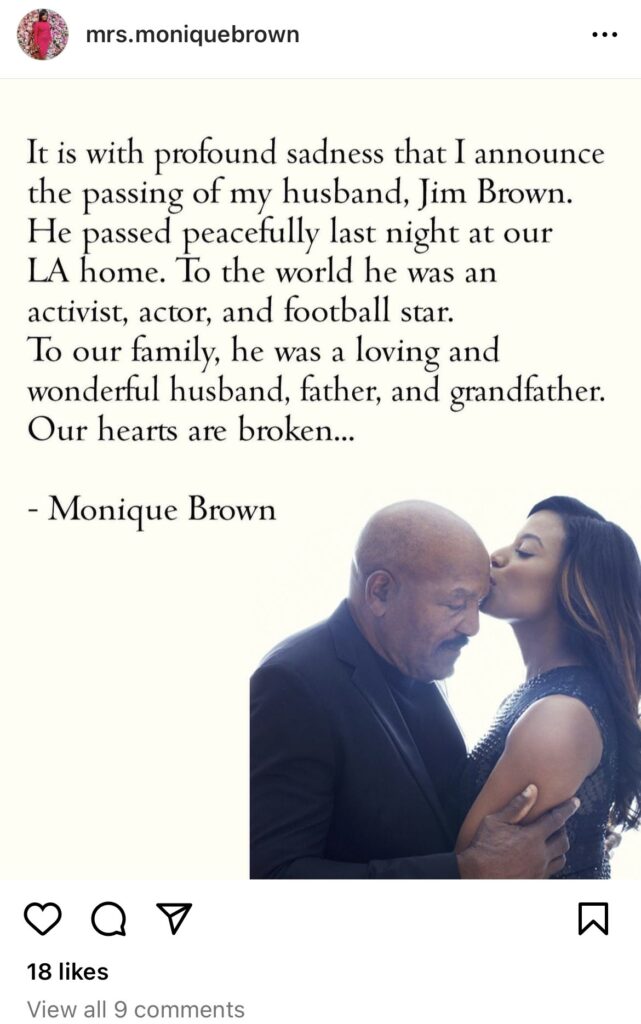
Reportedly, in 1966, Mr. Brown announced his retirement to pursue his acting career and other interests. After the 1965 season ended, Mr. Brown was filming “The Dirty Dozen” in London, when Cleveland Brown’s owner Art Modell issued an ultimatum by threatening to fine him if the running back was late or failed to show up to training camp. He was only 29 when he stepped away from the NFL.
“I honestly like you and will be willing to help you in any way I can, but I feel you must realize that both of us are men and that my manhood is just as important to me as yours is to you,” wrote Mr. Brown, in a letter attributed to him on andscape.com website. He held a press conference to announce his retirement from football, because of the future he desired for himself, his family and his race, according to the letter. Andscape, formerly The Undefeated, is a sports and pop culture website owned and operated by ESPN.
“Of course, I don’t think White America is going to remember him for that, but I truly believe that Black America and people all over the world will remember his stance on tyranny and injustice,” said Student Min. Muhammad.
“He was one of the first athletes to come from his lofty position into hell and work with the downtrodden. It just reminds me of what Jesus said to his disciples, when he talked about those who were in prison and you administered not unto them. That’s what Jim Brown did, and so his legacy among just the people in the streets became quite outstanding. He’s a hero to them. He was a leader to them. He was like a big-time advisor to the streets, so the streets will remember Jim as a revolutionary hero,” he added.
“I met Jim through Minister (Louis) Farrakhan, in 1989, through the ‘Stop the Killing’ tour,” stated Aqeela Sherrills, a co-founder of Amer-I-can. “Minister Farrakhan came to town and galvanized thousands of the folks from the city to come together around all of the killings that was happening in the city,” said Mr. Sherrills, who said he grew up in the Jordan Downs Housing Projects, and was a member of Grape Street Crips.
As an activist/organizer trying to stop the killing, he and colleagues took about 30 young Black men to hear Min. Farrakhan speak, said Mr. Sherrills.
“We were all so moved. Fifteen hundred Crips and Bloods showed up that day at the Sports Arena for that conversation and then Jim opened up his house as a neutral ground for us to meet and have conversation,” stated Mr. Sherrills.
He told The Final Call that because of the meeting hosted by the Minister and Mr. Brown, he had an opportunity to connect with them and represent his neighborhood. Mr. Brown gave him his phone number and invited him to visit his home any time he needed a break from the neighborhood, shared Mr. Sherrills.
“Jim was the catalyst, one of the key financiers behind the movement early on,” Mr. Sherrills continued. “Minister Farrakhan put out the call and Jim showed up and became more like a mentor and a father to many of us in L.A., and then across the country,” he stated.
For Mr. Sherrills the thing that Mr. Brown will be most remembered for in his life is his mentorship and guidance. “Jim was probably one of the most brilliant cats that I’ve ever met. I’ve never been in a room with J. B. where he hadn’t briefed us before we got there so that we could all be on the same page in terms of the conversation, and then debriefed after every meeting,” said Mr. Sherrills.
He described Mr. Brown as being far ahead of his time and said that in the ’60s when the talk was about civil rights, Mr. Brown was focused on human rights.
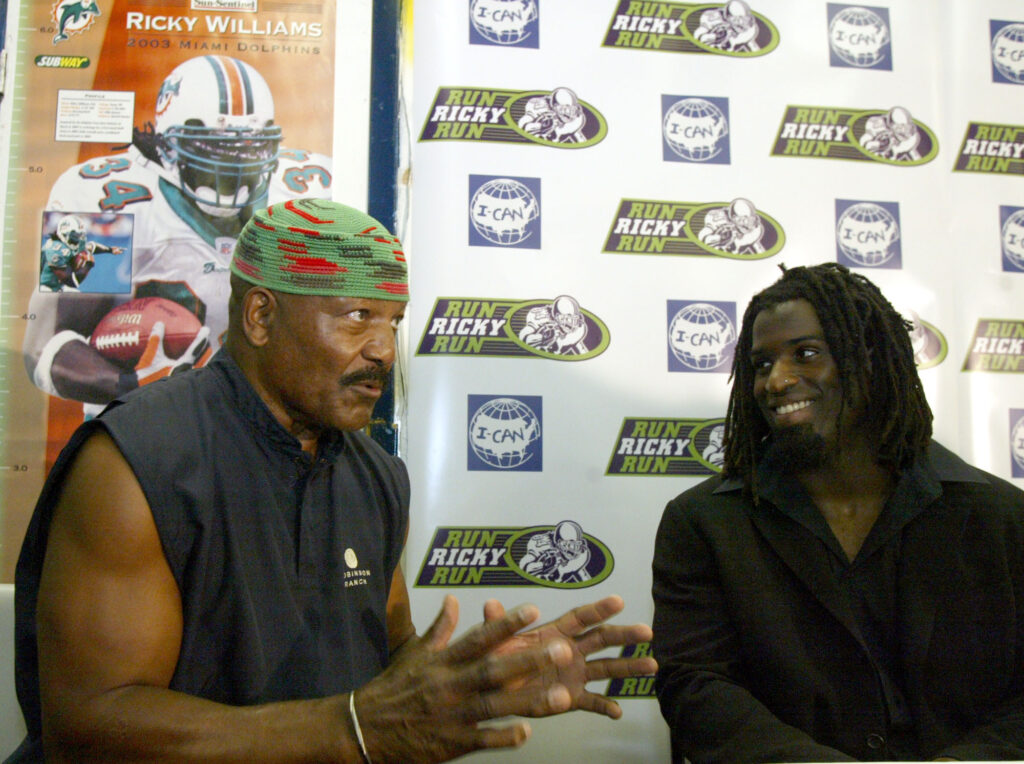
“Jim was there for me through all of my formative years and transformations and I love him forever for the contribution that he’s made to my life, but also to thousands. I traveled with Jim as his right hand for almost a decade to cities all across the country and it was just an honor always to be in service to something that was so much bigger than us and that’s the peace movement. And we see where things are today as a result of his work and the Minister’s work.”
Mr. Sherrills highlighted an example of the evolving approach to addressing street peace. He mentioned that under the Biden Administration, community-based solutions are now acknowledged as complementary strategies alongside the police. These strategies are seen as vital and worthy of investment to strengthen the country’s safety infrastructure, said Mr. Sherrills.
“There’s about three or four of us, national thought leaders in the country who were all trained by Jim, that are sitting at the table,” stated Mr. Sherrills, who added that in 2021, he ran the White House Community Violence Intervention Collaborative, a 16-city initiative to do a proof of concept, building the capacity of community violence intervention as a complimentary strategy to policing in cities.
From there came the 2022 bi-partisan Safer Communities Act, which he emphasized put $250 million into community violence intervention. “When we started this work in the late ’80s, early ’90s, Jim financed this work himself, with support from a few people! And now, we’ve got the federal government … at the foundation of that is J.B.,” Mr. Sherrills added.
Marcus Bell met Mr. Brown in 1997, through Darren “Bo” Taylor, deceased former Crip and gang mediator of Unity One gang intervention effort. Twenty-five years later, Mr. Bell teaches the Ameri-I-Can program in Chicago with Melvyn Hayward, co-founder with Ansar El Muhammad and Clinton Noble of Venice 2000 gang intervention and prevention.
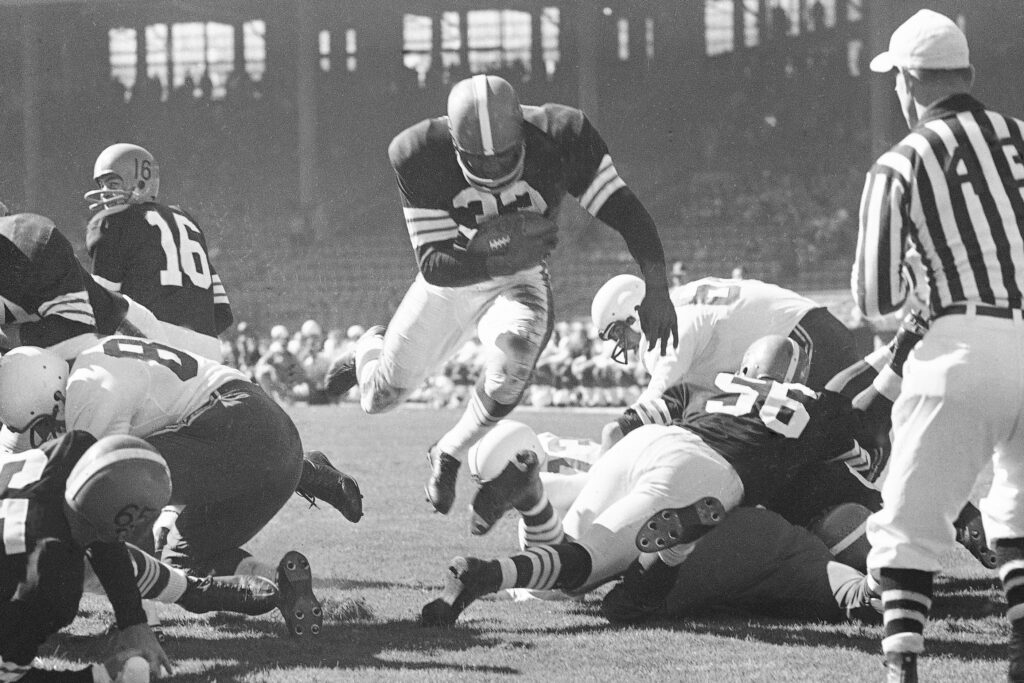
“He’s a humanitarian. He stopped playing football and lacrosse and Jim Brown just got into the community, which was on his heart,” said Mr. Bell. “It’s been a big impact because if it wasn’t for Jim Brown, speaking for myself, a lot of these communities would have had even more losses than what we had today, because we took that (Amer-I-Can) curriculum to them. … I can honestly say if it wasn’t for that curriculum, I’d probably have a life sentence or be dead,” Mr. Bell told The Final Call.
News of his mentor’s passing literally took him off of his feet, said Mr. Hayward, who is also chief program officer for Chicago CRED (Create Real Economic Destiny), an anti-gun violence organization.
“Jim means so much to me and us as a people, and knowing that Jim has been and was on the front line for over 50 years, representing Black people and our excellence and what it means to be Black in America and how we give back to one another and be consistent about our love in our education and our willingness to atone and reconcile with one another, it really touched my life,” stated Mr. Hayward.
Ansar El Muhammad reflected on Mr. Brown’s selflessness, care and humor. Mr. Brown funded their organization at $2,000 a month, according to Ansar El Muhammad, but one day he took them to meet a friend in Leimert Park. The late great NBA great Bill Russell exited a shop, and Mr. Brown told them, “Hey, Bill! These are the guys that you’ve been supporting for a whole year,’” said Ansar El Muhammad, as he laughed at the fond memory.
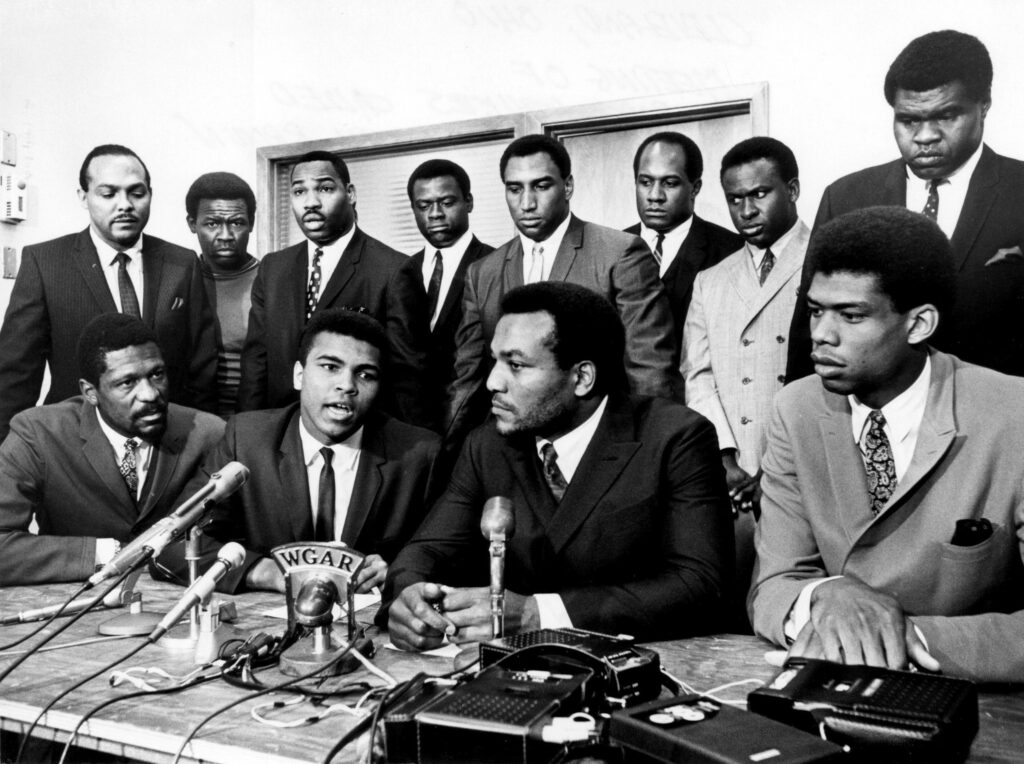
“I will remember Jim as more than an NFL player,” he said. The larger than life figure would state that though it was great to be in the NFL and Hall of Fame as an individual, the work being done through Amer-I-Can and organizing former gang members and ex-offenders and working with them is more fulfilling than anything he ever did in the NFL or Hollywood because he saw the transformation in the lives of human beings who were disregarded as individuals and who otherwise may never make it back into mainstream society,” added Ansar El Muhammad.
“He would say, ‘Hey! Gentlemen! It’s never too late to obtain a full, meaningful life!’ That stuck with me,” he added.
According to The Associated Press, Mr. Brown is survived by his wife Monique and son, Aris; daughter, Morgan, son, Jim Jr.; daughter, Kimberly; son, Kevin; daughter, Shellee; and daughter, Kim. He was preceded in death by his daughter, Karen Ward.












